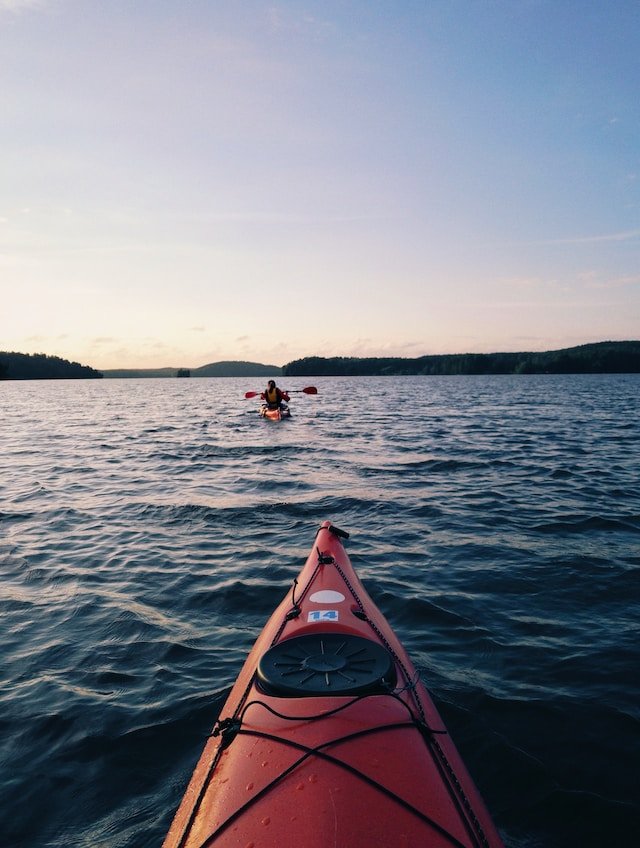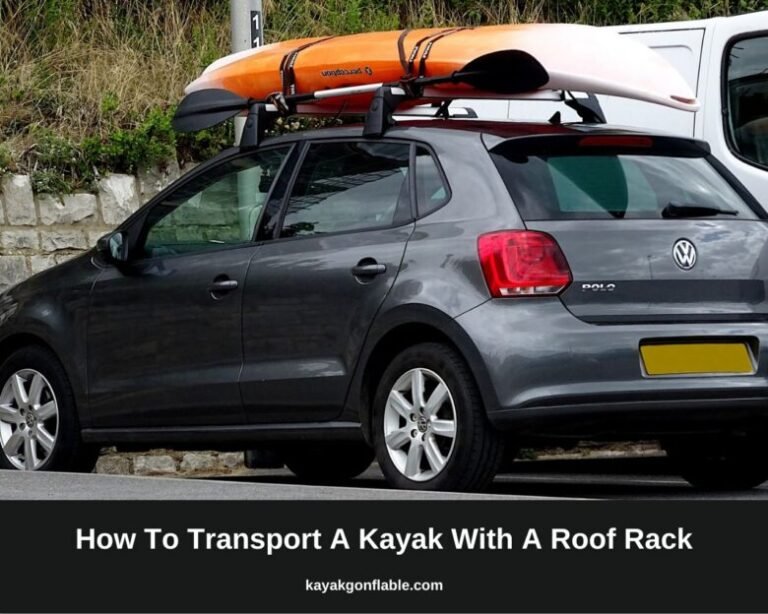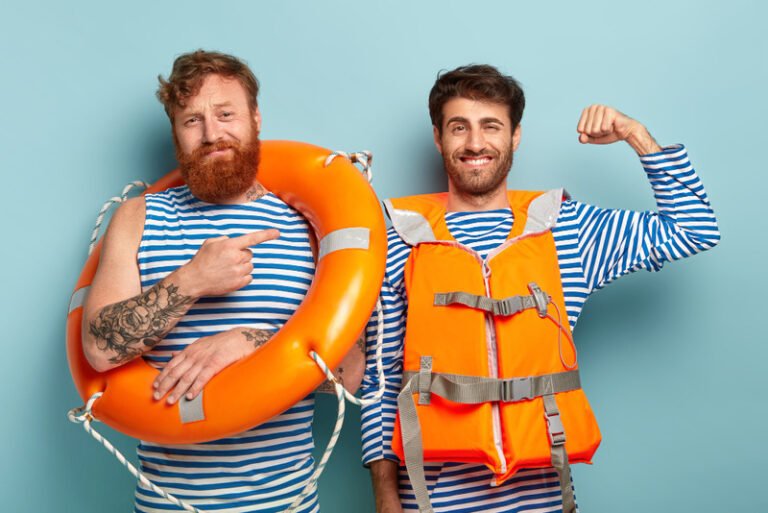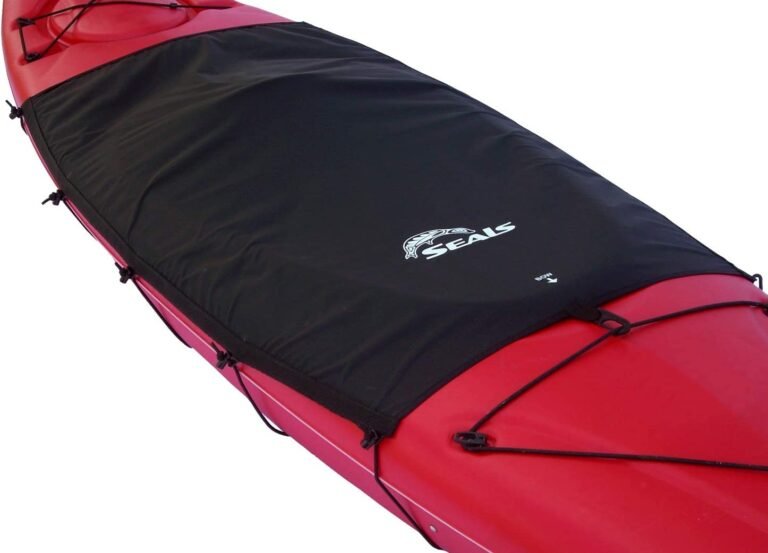¿Cuánto tiempo se tarda en recorrer una milla en kayak?

El kayak es un deporte de remo popular y, una vez que descubres sus placeres, deseas cada vez más encontrar el camino hacia el agua y divertirte. Naturalmente, no puedes navegar en kayak todo el tiempo y eventualmente tendrás que cronometrar tus viajes para aprovecharlos al máximo.
No pasará mucho tiempo antes de que te preguntes: "¿Cuánto tiempo me llevará recorrer una milla en kayak?" Necesita esta respuesta para saber cuánto tiempo pasará en el agua para poder hacer sus planes, especialmente si está realizando un recorrido o planificando una expedición.
La respuesta a esta pregunta varía con cada kayakista y depende de varios factores, incluida la experiencia del kayakista, el tipo de kayak en el que rema, la velocidad a la que rema, si toma descansos y las condiciones del viento y las olas.
Este artículo explica estos factores en detalle para ayudarle a determinar cuánto tiempo llevaría recorrer una milla en kayak.
¿Cuánto tiempo le tomaría al kayakista promedio recorrer una milla en kayak?
Un kayakista promedio es alguien a quien le gusta pasar tiempo al aire libre remando en lagos, ríos y arroyos. También pueden disfrutar de viajes ocasionales al océano.
Los kayakistas promedio suelen tener algunos conocimientos básicos de kayak y se sienten cómodos con las brazadas y maniobras básicas.
Algunos kayakistas promedio pueden incluso participar en carreras u otras competencias de vez en cuando. Sin embargo, la mayoría de los kayakistas promedio simplemente disfrutan del deporte como recreación y ejercicio.
Como kayakista promedio que disfruta principalmente del kayak como recreación y ejercicio, es posible que haya desarrollado una gran resistencia, pero no necesariamente mucha velocidad.
El kayakista promedio puede moverse por el agua a una velocidad de 2 a 3 millas por hora. Esto implica que navega en kayak una milla en unos 20 a 30 minutos en aguas tranquilas y planas.
Como se mencionó anteriormente, estas cifras pueden cambiar según varios factores pero, en general, independientemente de las condiciones que rodean a un kayakista, cubrirá una milla en aproximadamente 20 a 45 minutos.
Factores que afectan el tiempo que le llevaría recorrer una milla en kayak
En promedio, le tomará 30 minutos recorrer una milla en kayak si rema continuamente sin descansos en aguas relativamente tranquilas y planas.
El tiempo que te llevarías remando a la misma velocidad en un río disminuirá si vas a favor de la corriente, mientras que si vas contra la corriente aumentará.
Por lo tanto, es lógico que algunos factores afecten la velocidad del kayak y, por tanto, afecten el tiempo que llevará recorrer una milla en kayak. Estos factores incluyen:
- ¿Qué tan rápido puedes remar en un kayak?
- El tipo de kayak que estás remando
- Condiciones del agua
- Condiciones del viento
- Técnica de remada
¿Qué tan rápido puedes remar en un kayak?
En última instancia, la velocidad a la que un cubiertas de kayakista El estado líquido depende del viento, las olas y su velocidad. Incluso en las mejores condiciones, si remas con pereza, no podrás cubrir mucho terreno.
La velocidad de la mayoría de los remeros es de 2 a 2,5 nudos y los remeros más experimentados pueden alcanzar los 3 nudos. A esta velocidad, deberías poder navegar en kayak una milla en entre 20 y 30 minutos.
Tipo de kayak y velocidad del kayak
Como el kayak es un deporte para todos los que quieran participar en él, tiene varios tipos para atender a todos los aficionados y, por tanto, diferentes tipos de kayaks existen para diferentes propósitos. Los factores clave a la hora de comprar kayaks incluyen la velocidad, la estabilidad y la maniobrabilidad, pero nuestro enfoque es la velocidad.
El tipo de kayak que elijas tendrá una velocidad máxima que podrá alcanzar y esa velocidad afectará la rapidez con la que puedas recorrer una milla al remar en el agua. Para facilitar la comparación, examinaremos los tipos de kayak del más rápido al más lento en aguas tranquilas y planas.
Tenga en cuenta que los kayaks de aguas rápidas, por ejemplo, están diseñados para navegar rápidos y, como tales, no cubrirían mucho terreno en aguas tranquilas. Otra cosa interesante a tener en cuenta sobre las motos acuáticas, en general, es que cuanto más largas sean, más rápidas serán.
Entonces, si actualiza de un kayak recreativo de 10 pies a un kayak recreativo de 12 pies, por ejemplo, notará que puede moverse más rápido con la misma velocidad de remo. Del mismo modo, cuanto más estrecho sea el kayak, más rápido será.
- Kayaks de carrera de vigas delgadas: como su nombre lo indica, estas embarcaciones están diseñadas para brindar velocidad y agilidad. Son más estrechos que los kayaks tradicionales con un ancho de 20 pulgadas o menos. También son bastante largos.
- Kayaks de mar: Diseñados para kayakistas que aman remar en mares y océanos, estos kayaks son bastante rápidos para resistir las olas. Son similares a kayaks de travesía ya que son ideales para cubrir largas distancias rápidamente. Miden fácilmente más de 15 pies de largo y entre 23 y 24 pulgadas de ancho en promedio.
- Kayaks de travesía: Estos kayaks son ideales para quienes realizan excursiones o expediciones largas. Cubren el terreno rápidamente y generalmente miden entre 12 y 18 pies de largo. Los kayaks de travesía suelen tener un ancho de 26 pulgadas.
- Kayaks recreativos con asiento interior: en promedio, estas embarcaciones suelen tener 10 pies de largo y 28 pulgadas de ancho. Son adecuados para remar recreativamente y relajarse en el agua.
- Kayaks de recreo sit-on-top: No difieren mucho en longitud de la versión sit-inside. La principal diferencia está en el estilo de la cabina y en el hecho de que están hechos para ser más lentos pero más estables que sus contrapartes.
- Pesca kayaks: Cualquiera que haya ido a pescar sabe que la paciencia es muy importante. Por tanto, no sorprende que los kayaks diseñados para pescar sean bastante lentos, ya que no están pensados para la velocidad. Sin embargo, son muy estables y tienen una gran capacidad de almacenamiento.
- Kayaks de aguas bravas: Están diseñados para navegar rápidos y dar emoción, por lo que se mueven notablemente lentos y sin estabilidad en aguas planas y tranquilas.
Es fácil para un kayakista moverse a una velocidad de 2 a 2,5 nudos en un kayak de travesía, lo que le permite recorrer una milla en kayak en unos 30 minutos.
Si utiliza un kayak más rápido, como un kayak de mar, por ejemplo, puede reducir el tiempo hasta en 10 minutos, lo que significa que cubrirá una milla en unos 20 minutos.
Sin embargo, si usa un kayak más lento, como un kayak de pesca, agregará al menos 10 minutos a su viaje, lo que significa que recorrerá una milla en kayak en aproximadamente 40 a 45 minutos.
El tipo de kayak que utilices influye en gran medida en la rapidez con la que puedes moverte, así que asegúrate de tomar una decisión acertada. Dependiendo de su propósito, lo más probable es que desee optar por kayaks recreativos, turísticos o de mar.
Condiciones del agua
Las condiciones del agua determinarán naturalmente no sólo la velocidad a la que navegas en kayak sino también lo agradable que será tu experiencia de remar.
Remar en aguas planas y tranquilas es fácil y la rapidez con la que te mueves depende de qué tan rápido remas. Sin embargo, remar en aguas agitadas o turbulentas es una historia diferente, ya que hace que remar sea considerablemente más difícil.
Si las olas están en tu contra, no podrás cubrir mucho terreno e incluso podrías lastimarte. Las condiciones del agua generalmente se pueden agrupar en corrientes y mareas.
Condiciones actuales
Esto entra en juego cuando navegas en kayak en un río, arroyo, manantial u otro cuerpo de agua que tenga corrientes. La velocidad actual es la rapidez con la que fluye el agua en el cuerpo de agua y determina la rapidez con la que se moverá.
Digamos que estás remando en tu kayak a 2 nudos en un río que fluye a 2,5 nudos y te mueves con la corriente.
Su velocidad efectivamente se convierte en 4,5 nudos y notará que está cubriendo terreno líquido a una velocidad fenomenal. No ocurrirá lo mismo si estás remando río arriba y tienes que luchar contra la corriente.
Esto se debe a que perderás velocidad luchando contra la dirección del río y si el río fluye más rápido de lo que puedes remar en contra de él, no avanzarás e incluso podrías dejarte llevar por la corriente.
Antes de remar en cualquier cuerpo de agua, asegúrese de investigar y tener una idea de las condiciones del agua para ayudar a planificar su viaje.
Condiciones de marea
Tendrás que preocuparte por las mareas cuando navegues en kayak en un mar u océano y por el tiempo de remada hasta que la experiencia sea más placentera. Las mareas son causadas por la atracción gravitacional de la luna y el sol sobre los océanos de la Tierra.
La gravedad de la luna es más fuerte que la del sol, por lo que tiene un mayor efecto sobre las mareas. Las mareas son más altas cuando la luna está llena o nueva y más bajas cuando la luna está en su primer o último cuarto. El rango de marea, o la diferencia entre marea alta y baja, puede ser de hasta 15 pies (4,6 metros).
Para disfrutar al máximo de su experiencia de remar, debe navegar en kayak cuando las condiciones estén a medio camino entre la marea alta y la baja. Si queda atrapado en las mareas, remar de regreso a la orilla será difícil e inseguro.
Condiciones del viento
Aunque todas las condiciones climáticas influyen en lo agradable que puede ser tu experiencia de remar y en lo rápido que puedes moverte, las condiciones del viento juegan el papel más importante.
De manera similar a las condiciones actuales, si remas con el viento obtendrás un impulso y cuando remas contra el viento perderás velocidad.
También existe el problema de que cuanto más ligero, corto y ancho sea tu kayak, más probable será que se vea afectado por el viento. Esto es especialmente cierto en el caso de los kayaks ligeros que pueden desviarse fácilmente de su rumbo debido a un viento desfavorable.
Antes de practicar kayak, consulte siempre el pronóstico del tiempo y esté atento al viento mientras esté en el agua para asegurarse de tener una aventura de remo segura. Si el viento sopla en sentido contrario, se aconseja buscar refugio.
Técnica de remar
Un factor crucial que afecta la rapidez con la que remas y, por tanto, el tiempo que te llevará recorrer una milla en kayak es tu técnica de remada. Generalmente, existen dos técnicas de remo: la técnica de remo de ángulo bajo y la técnica de remo de ángulo alto.
- El estilo de remo de ángulo bajo: este estilo implica remar sumergiendo el remo en un ángulo relativamente bajo con respecto al agua. Implica el uso de un remo bajo y es un estilo de remo relajado y tranquilo. Si estás remando de esta manera, te tomaría más tiempo que alguien remando con la técnica de ángulo alto para recorrer una milla en kayak.
- El estilo de remo de ángulo alto: en este estilo de remo, el remo del kayakista es más vertical y, por lo tanto, forma un gran ángulo con respecto a la superficie del agua. Este estilo de remo es más rápido y agresivo que el estilo de remo de ángulo bajo. Si esta es tu técnica de remo, naturalmente cubrirás más terreno que aquellos que usan el estilo de ángulo bajo.
¿A qué velocidad se puede navegar en kayak en un kayak a pedales?
A kayak a pedales Es un tipo de kayak que se propulsa mediante pedales, en lugar de mediante un remo. Los pedales suelen estar situados en el medio del kayak y el ciclista se sienta encima del kayak.
Los kayaks a pedales son cada vez más populares, ya que ofrecen una forma más eficiente y con manos libres de remar. Son ideales para remar largas distancias, así como para pescar y fotografiar.
Las personas generalmente tienen piernas más fuertes que brazos, por lo que los kayaks a pedales facilitan la navegación en kayak, pero la velocidad a la que vayas aún depende de tu condición física y de lo rápido que puedas pedalear.
Los kayaks a pedales suelen tener una velocidad promedio de 3,5 a 4 nudos, por lo que cubrirá la distancia de una milla en aproximadamente 12 a 17 minutos, dependiendo de qué tan rápido reme.
Tanto en kayaks de remo como de pedales, la resistencia del kayakista es clave para mantener la velocidad y seguir su horario.
A una persona promedio le toma entre 20 y 45 minutos recorrer una milla en kayak. Esto puede variar según la experiencia de navegación en kayak de la persona, las condiciones climáticas actuales, el tipo de kayak que esté remando y la dificultad del terreno.
Con práctica y preparación adecuada, cualquiera puede disfrutar de remar tranquilamente río abajo o en aguas tranquilas; algunas personas pueden hacerlo más rápido mientras que otras pueden tardar un poco más.
Entonces, si alguna vez te apetece un desafío, cronometra y observa cuánto tiempo te lleva recorrer una milla en kayak.
¿Cuánto tiempo se tarda en recorrer 3 millas en kayak?
Con el tiempo, querrás extender tus sesiones de remo, y navegar en kayak 3 millas es un hito común. Debería llevarte unos 90 minutos recorrer en kayak 3 millas.
La sesión de remo pasará factura a tu energía, especialmente si es tu primera vez, así que lleva agua y algunas barritas energéticas durante el viaje. También debe tomar descansos según sea necesario para su buena salud.
¿Cuánto tiempo se tarda en recorrer 10 millas en kayak?
Si decide cubrir esta zona tan líquida, pasará aproximadamente 5 horas en el agua si tiene un promedio de 2 a 2,5 nudos.
Recuerda la importancia de los descansos, los refrigerios y la hidratación y todo irá bien.
Navegar en kayak durante 10 millas no es una broma y requerirá que desarrolles mucha resistencia y resistencia, así que asegúrate de estar preparado antes de embarcarte en la aventura.






